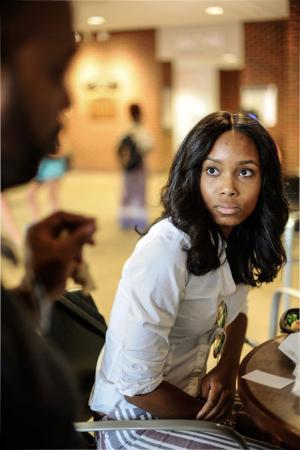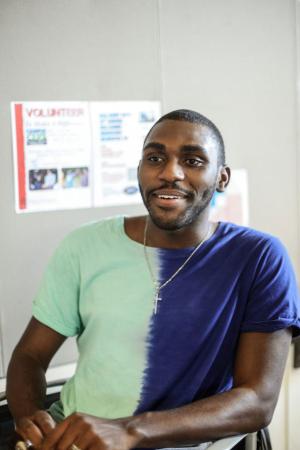Finding a Place: Black Students Navigate the White World at UGA
Ascend to the third floor of Memorial Hall at the University of Georgia, walk along the winding hallway, and you will come face to face with the emblems of UGA’s efforts to embrace diversity. The walls are covered with plaques and signs for the many groups serving students who are not white. There’s the Black Affairs Council, the Asian American Student Association, the Hispanic Student Association, the UGA chapter of the NAACP, the Multiracial Student Organization, the Black Male Leadership Society.
These groups are part of the 231-year-old university’s attempt to make its vast campus of 28,000 undergraduates feel less intimidating to nonwhite students. The message: No matter who you are, you can find a family at UGA.
But for black students, Athens can still be an unnerving place. Every year, when they step onto the campus for the first time, many black students find themselves surrounded by more white people than they have ever seen in one place in their lives. They heard the talk in high school that UGA was a “white school,” and now they are finding out what that means.
The University of Georgia is seen as the star of the state’s public higher-education system—an ambitious research university, flush with cash (endowment: $1 billion) and top professors and boasting an extensive network of diehard alumni who sweat UGA red, particularly during football season.
Black students represent just 7 percent of its student population (or about 2,000 undergrads), in a state where black students are 34 percent of all high-school graduates. Among the nation’s flagship state universities, only the University of Mississippi and Louisiana State show a wider disparity between black students on campus and the number of black high-school graduates in the state, according to a Hechinger Report analysis.
“Most of our kids are used to going to schools where they are in the majority,” said Virgil Murray, executive director of the Maynard Jackson Youth Foundation, an Atlanta-based program that helps high-achieving African-American students reach top-notch colleges and professional careers. “They go to Georgia, and they are not.”
Interviews with black students on the Georgia campus revealed that while they have not often encountered racial strife in classrooms, they sometimes experience unpleasantness because of their race in the dorms and in social situations. UGA junior Morgan Ukaonu, 20, and her friend Jalen Gregory, 21, a senior, said that they have received subtle digs or snide comments from white students many times.
“I don’t know why, but it’s usually where we all live,” said Ukaonu, an entertainment and media studies major who graduated from the highly regarded Henry W. Grady High School in Midtown Atlanta. “It can be subtle things, but being in the South, one thing you notice is that people are very well-mannered. So when I see or experience certain things that don’t resemble that, it stands out. And it’s happened multiple times.”
Often, the instances are “people being rude nonverbally,” she said, “such as the time when I held the door for a guy and he went through the door right next to it, and didn’t acknowledge the fact that I was holding the door for him.”
Sterling Crossley, a 19-year-old sophomore, said a group of his friends, all black, went to a white fraternity party last year and were told they had to leave because “the cops were coming.”
“But then they continued partying,” Crossley said. “My friends knew the cops weren’t coming. I’ve heard stories like that a couple of times.”
Murray, whose program counsels about two dozen high-school seniors every year, said he’s had four students from his program transfer from UGA in the last several years because they didn’t feel comfortable or supported on campus.
“I try to tell them when you go to University of Georgia, it is going to be a cultural change,” said Murray, adding that many white students come to UGA from rural areas, where they aren’t used to being around black students. “In the living areas is where people are more themselves, and you see who they really are. That’s where some sensitivity training could be provided for all students on the campus.”
And then there are the football games.
“You feel unity at the games—until they get drunk and we start losing,” said Gregory, a journalism major. “Then they can get really rude.”
Reports of this kind of discomfort often get back to the high schools from which these students came, leading many high-achieving black high-school seniors to avoid even applying to UGA, many students said. Many turn instead to Georgia State, where more than one-third of the undergraduate population is black.
“I can understand where people are coming from when they say UGA is a white school,” said sophomore Morgan Guthrie, 19. “Even when you tour here, you don’t really see many of us walking around. If they don’t see people that look like them, they are less inclined to come.”
Patrick M. Winter, associate vice president in the university’s admissions office, said the school “works diligently” to recruit and retain a diverse student body.
“As admission to UGA has become more competitive, it continues to be a priority to identify and encourage qualified African-American students to apply,” Winter wrote in an email, citing the office’s many outreach campaigns, as well as programs such as the African American Male Experience and Georgia Daze, which bring prospective students to the campus while they are high-school seniors, with the hope that they will see diversity in action in Athens.
And Winter said the numbers are improving; the black student enrollment among freshmen who entered UGA this fall was 8.4 percent, or about 500 students, compared to 7.4 percent of the class that entered in 2006, or about 375 students.
Murray, of the Maynard Jackson program, said the university has an obligation to keep increasing that number. “We are taxpayers, too. We help pay for those salaries and administration at UGA,” he said. “They can’t say ‘we’re doing a good job’ based on these numbers.”
When black students at UGA need to feel a rejuvenating caress from kindred spirits, they know
where to go. They call it “Tate Time.” Every weekday beginning at about 11 a.m., the plush chairs and couches outside the food court in the Tate Student Center start to fill up with black students chatting, flirting, studying, eating—enjoying the comfort of a space they have carved out as their own.
“You can study in Tate Time around people who look like you, in a comfortable space, and you can be how you want to be, talk how you want to talk, without being judged or feeling awkward,” said Mansur Buffins, 20, a junior who is president of the UGA chapter of the NAACP.
To those who would ask why black students, or Asian students or Hispanic students, choose to engage in this type of self-segregation, these students respond that no one questions the sight of a large group of white students socializing together.
The existence of Tate Time speaks to the vexing question that black parents and students have confronted for decades: How to find that elusive campus offering an education that will kick open doors in the professional world, along with an environment where black students will feel respected and even championed.
“If you’re a university, and you have black students, underrepresented students, students in oppressed groups, then you should be making every effort to make them feel comfortable, safe, secure,” Buffins said. “Especially if you are a PWI [predominantly white institution] in the South, with those historical legacies that are pretty terrible.”
Stan Jackson, the university’s director of student affairs communications and marketing initiatives, said when he hears black high-school students talk about fears that the UGA campus is intimidating, he believes it’s because they’re unaware of the efforts the university is making.
“There are a lot of resources we offer here on campus, and there’s no way that type of detail is going to get down to a high-school student,” he said. “One of the things I commonly hear from students is, ‘Oh, I didn’t know about this. I didn’t know this was here. If I’d only known this, it would have made my decision a lot more informed.’
“It’s a little bit on the University of Georgia to do better,” he added. “To get out there and say, ‘Of course there’s a spot for you. We want to be welcoming and here for you.’”
Buffins, of the campus NAACP chapter, said he can see the considerable efforts UGA is making to create a campus that is comfortable for nonwhite students. “I’d give them between a B-plus and an A-minus in that area,” he said.
But Guthrie said there is only so much UGA officials can do. “The higher-ups can try their best, but we’re not going to class with them, we don’t see them everyday, we’re not interacting with them everyday,” she said. “That’s where the disconnect is.”
Just 70 miles away, in downtown Atlanta, is UGA’s less prestigious cousin, Georgia State University. More than a third of its 25,000 undergraduates are black, and it has been heralded nationally for its commitment to the success of black students. In fact, Georgia State now graduates more black students every year than any college in the United States.
This glaring contrast presents black students in the Peach State with a choice: At the risk of oversimplifying, it’s prestige versus comfort.
“Students here feel that UGA has more prestige,” said Morgan Palmer, 19, a UGA sophomore. “That’s the first thing they talk about when someone says they want to transfer because they feel out of place—that you won’t get as good an education.” That prestige is weighed against the comfort of Georgia State, which some students say feels almost like a historically black college.
Michelle Garfield Cook, associate provost and chief diversity officer at UGA, said her office’s mission is to keep pushing to create a campus “that fosters diversity and inclusion.”
As evidence of success, Cook pointed out that UGA for the past three years has received a Higher Education Excellence in Diversity (HEED) Award, presented by the magazine INSIGHT Into Diversity to schools that demonstrate a commitment to diversity and inclusion in their programs, hiring practices and student recruitment, retention and completion. UGA was one of 83 schools to receive the award this year; so was Georgia State.
This story was produced by The Hechinger Report—a nonprofit, independent news organization focused on inequality and innovation in education—and is reprinted with permission.












comments